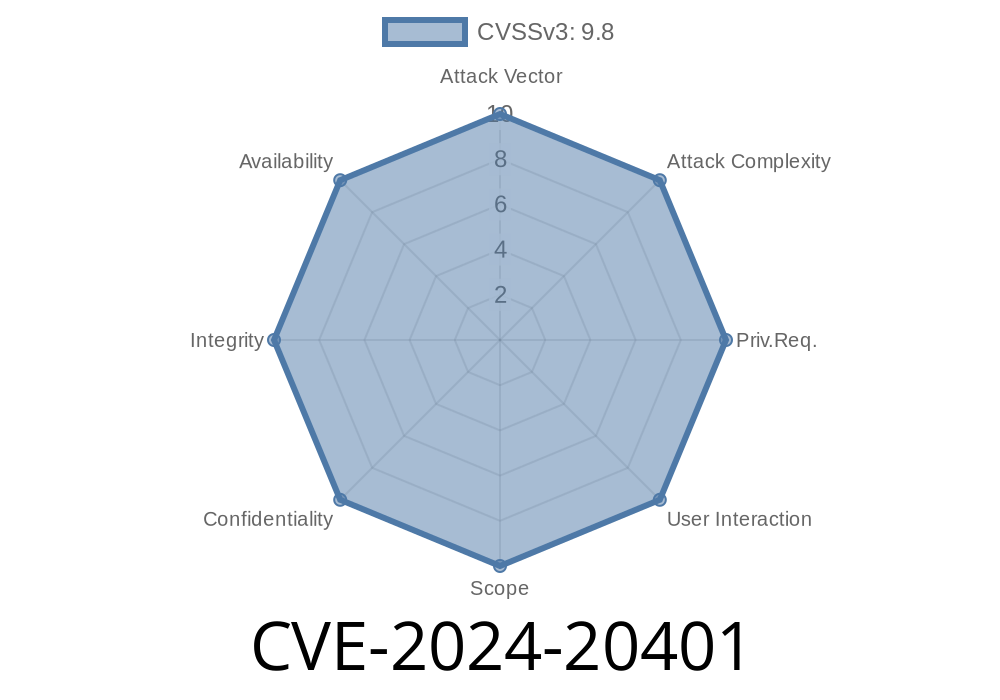A newly disclosed vulnerability, CVE-2024-20401, poses a severe risk to organizations using Cisco Secure Email Gateway. This high-impact vulnerability lets anyone on the internet send malicious emails that can overwrite files on the internal system—no username or password required. In this post, we’ll explain how CVE-2024-20401 works, show you code snippets and attack details, and outline what you should do to stay protected.
What is CVE-2024-20401?
In simple terms, CVE-2024-20401 is a flaw in how Cisco Secure Email Gateway handles file attachments when doing virus and content scans. When certain filters are turned on, attackers can exploit a logic mistake to trick the system into writing files to any location on the server.
Impact:
Overwrite critical system files
- Insert new users (with root/admin privileges)
Full system takeover
Once the exploit is successful, recovering from it may need manual intervention from Cisco support.
Let’s break down the attack in simple steps
1. Attacker crafts an email: The email contains a specially made attachment. This file is structured in a way that abuses the Secure Email Gateway’s scanning feature.
2. The gateway scans the attachment: When file analysis and content filters are activated, the gateway mishandles the file path or filename.
3. Arbitrary file overwrite: Instead of saving the attachment to a safe, temporary directory, the system writes it to any path defined in the attachment's metadata. If the attacker sets this to, say, /etc/passwd, the system replaces the critical file.
A ZIP file is created with a *symlink* inside, pointing to /etc/passwd
ln -s /etc/passwd evilfile
zip --symlinks evil.zip evilfile
Step 2: Sending the Malicious Email
The attacker sends an email to any address that will be processed by the target Cisco Secure Email Gateway. The email includes the evil.zip as an attachment.
Step 3: Exploiting the Processing Logic
When the Gateway scans evil.zip, it extracts the symlinked file without validation, overwriting /etc/passwd with attacker-controlled data.
What does this mean?
If the new /etc/passwd contains a user with UID , the attacker can SSH in as root once they set the right password.
Example /etc/passwd line to insert
evilroot:x:::root:/root:/bin/bash
Potential Real-World Impacts
- Permanent DoS: If system files are corrupted, the device may not boot. *Manual intervention from Cisco engineers will be needed* (Cisco Security Advisory).
Persistent Compromise: New root-level users can be created to maintain backdoor access.
- Lateral Movement: Attackers can pivot into the rest of the enterprise network using the compromised gateway as a launchpad.
Cisco Security Advisory:
Cisco Secure Email Gateway Vulnerability (CVE-2024-20401)
NIST NVD Entry:
How to Protect Yourself
- Patch Immediately: Cisco has released software updates fixing this bug—update your Secure Email Gateway as soon as possible.
- Monitor Critical Files: Watch for any unauthorized changes to key files (like /etc/passwd).
- Restrict Email Attachment Types: Consider blocking risky attachment types if patching is delayed.
- Prepare for Manual Recovery: Know your process and how to reach Cisco TAC (link) in case your device is locked up.
Conclusion
CVE-2024-20401 is a critical vulnerability that turns your Cisco email gateway into a potential launchpad for attackers. With a simple, crafted email, they can take over your device or knock it offline permanently.
Act now: Patch, monitor, and be ready to respond—before someone else gets in first.
Stay safe!
*This post is an original explanation based on Cisco’s own advisories and risk analysis. For full technical details and patch availability, visit the official Cisco Security Advisory.*
Timeline
Published on: 07/17/2024 17:15:13 UTC
Last modified on: 07/19/2024 03:55:39 UTC
